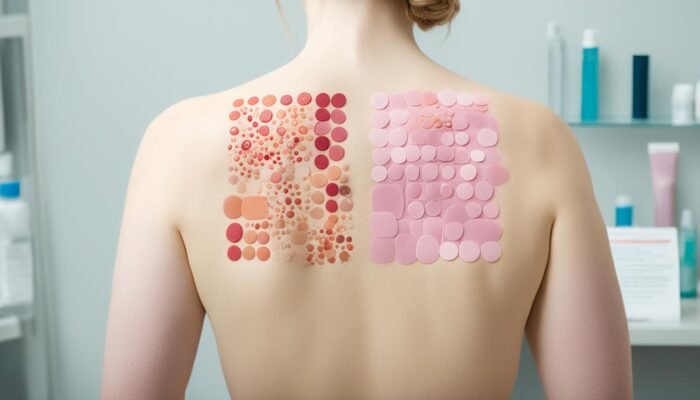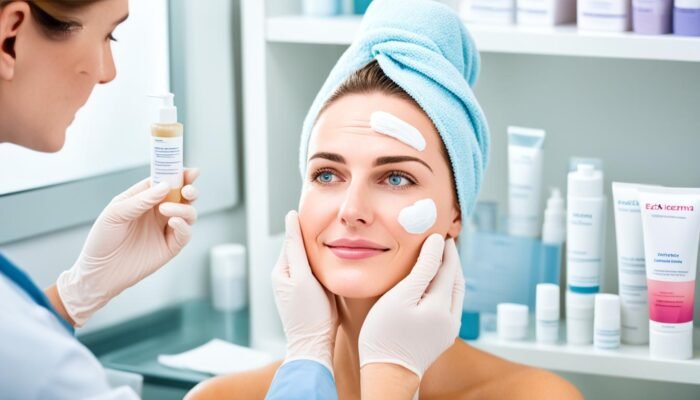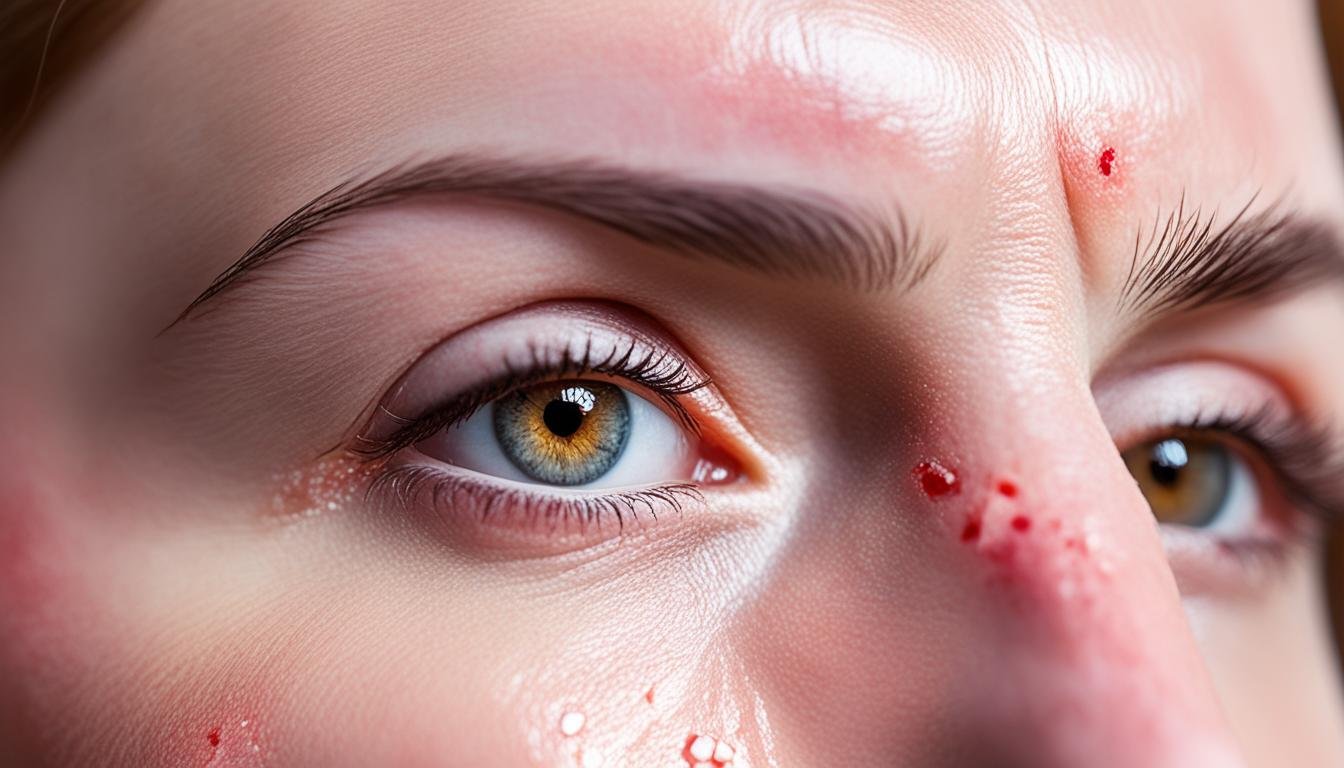About 31 million Americans, or nearly 10% of the population, deal with eczema. This condition is common on the face, causing redness, itching, and flaky patches. It can really affect one’s life. Knowing what causes and how to treat facial eczema is key to managing it.
Contents
- 1 Introduction to Facial Eczema
- 2 Types of Facial Eczema
- 3 Causes of Facial Eczema
- 4 why eczema on face
- 5 Irritant Contact Dermatitis
- 6 Allergic Contact Dermatitis
- 7 Light Sensitive Eczema
- 8 Treatment of Facial Eczema
- 9 Conclusion
- 10 FAQ
- 10.1 What is facial eczema?
- 10.2 What are the common symptoms of facial eczema?
- 10.3 What are the main types of facial eczema?
- 10.4 What can trigger facial eczema?
- 10.5 Why does eczema often affect the face?
- 10.6 What is irritant contact dermatitis?
- 10.7 What is allergic contact dermatitis?
- 10.8 What is light-sensitive eczema or photodermatitis?
- 10.9 How can facial eczema be managed?
Key Takeaways
- Facial eczema, also known as atopic dermatitis, is a common skin condition that affects millions of Americans.
- The causes of facial eczema can include irritants, allergens, environmental factors, and underlying genetic or immune system factors.
- Effective treatments for facial eczema may involve moisturizing, avoiding triggers, and using medication or therapies as prescribed by a healthcare professional.
- Proper skin care and management of facial eczema can help alleviate symptoms and improve overall skin health.
- Seeking medical advice from a dermatologist or other healthcare provider is recommended for those struggling with persistent or severe facial eczema.
Introduction to Facial Eczema
What is Facial Eczema?
Facial eczema, also known as atopic dermatitis, is a chronic skin condition. It mainly affects the face. It causes red, itchy, and dry skin that can become flaky and irritated. Many people, including kids and adults, get this skin condition.
Common Symptoms of Facial Eczema
The symptoms of facial eczema can vary. Some people have short-term flare-ups, while others have ongoing issues. The skin may look red or darker than usual. It can also become weepy, crusty, or blistered.
People with facial eczema often have dry skin, itchy skin, and flaky skin.
Atopic dermatitis (AD) often starts before a child turns 5. Seborrheic dermatitis (SD) is the most common type in adults. It affects areas like the scalp, chest, ears, and forehead.
Things that can make eczema worse on the face include stress, sunlight, hormonal changes, weather, cigarette smoke, scented products, and food allergies. It’s important to take good care of your skin. This means moisturizing and avoiding things that irritate it.
Types of Facial Eczema
There are two main types of facial eczema: atopic eczema and seborrheic dermatitis. Knowing the differences between them is key for managing and treating the condition.
Atopic Eczema
Atopic eczema, also known as atopic dermatitis, is the most common type. It often affects the face in babies and kids. This eczema type causes dry, itchy, and inflamed skin.
Triggers for atopic eczema include low humidity, irritants, dust mites, animal hair, hormonal changes, food allergies, and some medicines.
Seborrheic Dermatitis
Seborrheic dermatitis is a milder eczema type. It shows up as dry, scaly skin around the ears and eyebrows. This condition is linked to an overgrowth of a skin yeast called Malassezia.
It can be triggered by stress, illness, hormonal changes, or certain medical conditions like Parkinson’s disease.
Knowing the differences between atopic eczema and seborrheic dermatitis helps in managing facial eczema. By understanding each type’s symptoms and triggers, people can work with healthcare professionals to find the right treatment. This helps reduce the discomfort and frustration of facial eczema.
Causes of Facial Eczema
Facial eczema is a common skin issue. It can be caused by irritants and allergens. Knowing what causes it helps in managing and treating it.
Irritants and Allergens
Exposure to irritants and allergens often leads to facial eczema. Common irritants include soaps, foaming washes, and makeup. Allergens like fragrances and preservatives can also cause an immune system overreaction, leading to eczema.
- Cosmetics and toiletries with harsh chemicals can harm the skin’s barrier, causing irritation and inflammation.
- Fragrances and preservatives in personal care products can trigger allergic reactions, making the skin red, itchy, and inflamed.
Environmental Factors
Environmental factors also play a part in facial eczema. Changes in temperature, humidity, and harsh weather can trigger eczema flare-ups.
- Extreme temperatures, whether hot or cold, can make the skin dry and irritated, making eczema worse.
- Changes in humidity can disrupt the skin’s moisture balance, leading to dryness and sensitivity.
- Harsh weather conditions like wind and sun can make eczema symptoms worse on the face.
Understanding facial eczema’s causes helps people take steps to avoid triggers. This can help manage the condition and improve skin health.
why eczema on face
Eczema, also known as atopic dermatitis, is a common skin condition. It can affect the delicate facial skin a lot. The face is more likely to get eczema because of its skin type.
The skin on the face is thinner and more fragile than other body parts. This makes it more open to irritants and allergens. These can cause inflammation and lead to eczema.
Things like dry air, cold weather, and harsh chemicals can hurt the skin’s barrier. Stress and hormonal changes can also make eczema worse on the face.
People with a family history of eczema or sensitive skin are more likely to get it on their face. It often starts in early childhood, between 6 months and 5 years.
Managing facial eczema means taking good care of your skin and avoiding triggers. Using gentle cleansers and moisturizers helps keep the skin healthy. If it’s bad, seeing a healthcare professional is a good idea to talk about medication.
Knowing how facial skin works and what causes eczema can help you manage it. Taking steps to care for your skin can keep it healthy and looking good.
Irritant Contact Dermatitis
Irritant contact dermatitis is a common type of eczema, making up 80% of contact dermatitis cases. It happens when the skin reacts to certain products or environmental factors, often on the face. Knowing what causes it is key to managing it.
Cosmetics and Toiletries: Potential Irritants
Even products called “dermatologically-tested” or “natural” can irritate the skin and make eczema worse. Things like cosmetics, toiletries, and personal care items can upset the skin’s balance. This leads to inflammation and irritation. People who work with chemicals daily, like healthcare workers or hairstylists, are more likely to get this condition.
Weather Changes: A Skin-Disrupting Factor
Changes in weather, like strong winds, rain, and sudden temperature changes, can make irritant contact dermatitis worse. These changes can break down the skin’s protective layer. It makes the skin more prone to irritation and inflammation. Taking good care of your skin and being proactive is important during these times.
| Irritant | Common Examples | Potential Effects |
|---|---|---|
| Cosmetics and Toiletries | Soaps, detergents, solvents, shampoos, makeup, and personal care products | Disruption of the skin’s natural balance, leading to inflammation and irritation |
| Weather Changes | Harsh winds, rain, and sudden temperature shifts | Disruption of the skin’s protective barrier, leaving it vulnerable to irritation |
People with irritant contact dermatitis can take steps to help manage their symptoms. Avoiding known irritants, using gentle, fragrance-free products, and moisturizing often can help. In serious cases, doctors may suggest topical corticosteroids or other treatments to reduce discomfort and inflammation.
Allergic Contact Dermatitis
Allergic contact dermatitis is a type of eczema that can happen on the face. It occurs when the immune system overreacts to something like fragrances or ingredients in eczema treatments. This reaction can take a few hours or days to show up, making it hard to find the cause.
Common Allergens
Some common things that can cause allergic contact dermatitis on the face include:
- Nickel, often found in jewelry and metal fasteners
- Fragrances in cosmetics and personal care products
- Preservatives like formaldehyde and parabens
- Ingredients in hair dyes, such as paraphenylenediamine
- Rubber chemicals found in gloves and other rubber products
- Topical medications, including antibiotics and antifungals
Patch Testing: Identifying the Culprit
A dermatologist may do a patch test to find out what’s causing the allergic contact dermatitis. This means putting small amounts of possible allergens on the skin and watching for reactions over a few days. Knowing the allergen helps the dermatologist guide you on how to avoid it and treat the condition.
Dealing with allergic contact dermatitis can be tough and ongoing. But, finding and avoiding the allergen can help manage symptoms and aid healing. See a dermatologist to figure out what’s causing your eczema and get a treatment plan that’s right for you.

“Allergic contact dermatitis can be triggered by even tiny amounts of allergens, so it’s crucial to identify and avoid the culprit substances.”
Light Sensitive Eczema
Some people find that their facial eczema gets worse with certain lights. This is called light-sensitive eczema or photodermatitis. It can happen with natural sunlight or artificial lights, making eczema on the face worse.
When eczema comes from ultraviolet light, it’s called ‘photosensitive eczema.’ If your eczema gets worse when you’re in the sun, you should talk to a doctor. They can figure out if it’s from your medicine or something else.
The sun can be harmful all year, but most of the time it’s worse from March to October in the UK. To deal with light-sensitive eczema, wear protective clothes, stay in the shade, and use sunscreen with an SPF of 50 or higher.
Choosing the Right Sunscreen
Finding the right sunscreen for eczema can take some trying out different kinds. Many people with eczema prefer mineral-based sunscreens because they’re less likely to cause irritation. These sunscreens don’t leave a white mark on the skin either.
Put on moisturizer before applying sunscreen to protect your skin from drying out. Remember to reapply sunscreen every 2 hours or after swimming, sweating, or drying off with a towel. This keeps your skin protected.
Medication and Photosensitivity
A 2019 study found that over 20% of medicines for older adults can cause skin problems from the sun. A 2020 study also showed that people with sun-sensitive skin might not get enough vitamin D. This is because they stay indoors more to avoid the sun.
If you feel weak, have headaches, or get a fever with chills after being in the sun, see a doctor. These could be signs of a sun sensitivity or another health issue.
To manage light-sensitive eczema, protect yourself from the sun, avoid harsh lights, and work with your doctor. They can help you find ways to deal with the condition.
Treatment of Facial Eczema
Managing facial eczema means moisturizing and avoiding triggers. Keeping the skin moisturized helps repair the barrier and lessen dryness. It’s important to stay away from irritants like some cosmetics and environmental factors to prevent flare-ups.
Moisturizing and Avoiding Triggers
Keeping up with a moisturizing routine is key for facial eczema. Choose fragrance-free, hypoallergenic moisturizers to keep the skin’s oils in balance. Avoid harsh soaps and certain cosmetics that can make your symptoms worse.
Medication and Therapies
Your doctor may suggest medications or therapies for your eczema. Topical corticosteroids or immunomodulators can lessen inflammation. Light therapy, like narrowband UVB, can also help, but it has risks like premature aging and skin cancer.
Managing facial eczema well means moisturizing, avoiding triggers, and using the right medications or therapies. With the right treatment, you can control your symptoms and better your skin’s health and look.

Eczema is a long-term condition, so sticking to a consistent treatment plan is vital. Always work closely with your healthcare provider to find the best ways to manage your eczema and improve your life.
Conclusion
Facial eczema is a tough skin issue that can really affect your life. Knowing what causes it, like irritants and allergens, helps you manage it better. This way, you can improve your skin’s health and look.
Using good moisturizers, avoiding triggers, and getting the right medical help can help manage facial eczema. It’s important to work with your doctor to find a treatment plan that fits your needs.
By taking a full approach to your eczema, you can lessen discomfort and symptoms. This can also lower the risk of serious problems and boost your health. Stick to your skin care routine, watch out for what sets off your eczema, and get help when you need it. With the right steps and support, you can beat the challenges of facial eczema and have healthier, more comfortable skin.
FAQ
What is facial eczema?
Facial eczema, also known as atopic dermatitis, is a chronic skin condition. It affects the face and is marked by red, itchy, and dry skin. This can become flaky and irritated.
What are the common symptoms of facial eczema?
Symptoms include red or darker skin, itchiness, dryness, flakiness, and sometimes, the skin may appear weepy, crusty, or blistered.
What are the main types of facial eczema?
There are two main types: atopic eczema and seborrheic dermatitis. Atopic eczema often hits infants and children on the face. Seborrheic dermatitis is milder, causing dry, scaly skin around the ears and eyebrows.
What can trigger facial eczema?
Many things can trigger it, like certain cosmetics, toiletries, and personal care products. Allergens like fragrances and preservatives can also cause it. Environmental factors, such as temperature and humidity changes, can make it worse.
Why does eczema often affect the face?
The skin on the face is sensitive and delicate. It has a thin barrier that can easily break, letting irritants in and causing inflammation.
What is irritant contact dermatitis?
It’s a type of eczema caused by exposure to certain products or environmental factors. Things like cosmetics and weather changes can disrupt the skin’s moisture balance and barrier.
What is allergic contact dermatitis?
This type of eczema is caused by an allergic reaction to something, like fragrances or preservatives. It can affect the face and worsen eczema symptoms.
What is light-sensitive eczema or photodermatitis?
This condition makes facial eczema worse with sunlight or artificial light. It leads to more inflammation and worsens eczema symptoms.
How can facial eczema be managed?
Managing it involves moisturizing, avoiding triggers, and using treatments like topical corticosteroids or light therapy. A healthcare provider can recommend the best approach.

